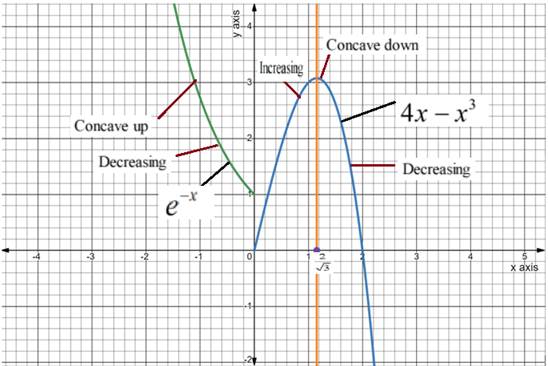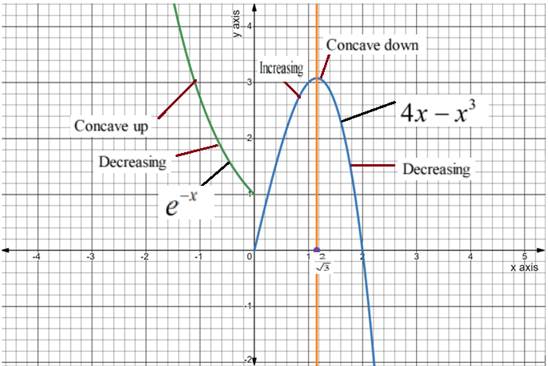
a.
To Find: The intervals on which the function is increasing using analytical method.
a.
Answer to Problem 13RE
Function
Explanation of Solution
Given:
Function
Concept used:
If the derivative of a function is positive on an interval, then the function is increasing on that interval.
Also, if the derivative of a function is negative on an interval then the function is decreasing on that interval.
Calculation:
First derivative of
Differentiate the
Case 1: when
Since,
Hence,
Case 2:- when
According to a known result
Thus,
So,
Conclusion:
Function
b.
To Find: the intervals on which the function is decreasing using analytical method.
b.
Answer to Problem 13RE
Function
Explanation of Solution
Given:
Function
From part (a),
Concept used:
If the derivative of a function is positive on an interval, then the function is increasing on that interval.
Also, if the derivative of a function is negative on an interval then the function is decreasing on that interval.
Calculation:
First derivative of
Case 1:- when
Since,
Hence,
Case 2:- when
According to result mentioned above
So,
Conclusion:
Function
c.
Find the intervals on which the function is concave up using analytical method.
c.
Answer to Problem 13RE
Function
Explanation of Solution
Given:
Function
First derivative of
Concept used:
If the second derivative of a function is positive on an interval, then the function is concave up on that interval.
Also, if the second derivative of a function is negative on an interval then the function is concave down on that interval.
Calculation:
First derivative of
Second derivative of
Differentiate the
Case 1: when
Since,
Hence,
Case 2:- when
According to a known result
So,
Conclusion:
Function
d.
Find the intervals on which the function is concave down using analytical method.
d.
Answer to Problem 13RE
Function
Explanation of Solution
Given:
Function
First derivative of
Second derivative of
Concept used:
If the second derivative of a function is positive on an interval, then the function is concave up on that interval.
Also, if the second derivative of a function is negative on an interval, then the function is concave down on that interval.
Calculation:
Second derivative of
Case 1:- when
Since,
Hence,
Case 2:- when
According to a known result
So,
Graph of function

Conclusion:
Function
e.
Find local extreme values using the graph.
e.
Answer to Problem 13RE
Function has
Explanation of Solution
Given:
Function
Graph of function:

Calculation:
According to the graph,
Function has local
Conclusion:
Function has local maxima at
f.
Find inflection points using the graph.
f.
Answer to Problem 13RE
No inflection points.
Explanation of Solution
Given:
Function
Graph of function

Concept used:
Inflection point: - A point of inflection on a curve is a continuous point at which the function changes its concavity.
Calculation:
According to the graph,
Function has jump discontinuity at
But, according to the definition of inflection point function should be continuous at inflection point. So, the given function does not have inflection point.
Conclusion:
No inflection points.
Chapter 4 Solutions
Advanced Placement Calculus Graphical Numerical Algebraic Sixth Edition High School Binding Copyright 2020
- A 20 foot ladder rests on level ground; its head (top) is against a vertical wall. The bottom of the ladder begins by being 12 feet from the wall but begins moving away at the rate of 0.1 feet per second. At what rate is the top of the ladder slipping down the wall? You may use a calculator.arrow_forwardExplain the focus and reasons for establishment of 12.4.1(root test) and 12.4.2(ratio test)arrow_forwarduse Integration by Parts to derive 12.6.1arrow_forward
- Explain the relationship between 12.3.6, (case A of 12.3.6) and 12.3.7arrow_forwardExplain the key points and reasons for the establishment of 12.3.2(integral Test)arrow_forwardUse 12.4.2 to determine whether the infinite series on the right side of equation 12.6.5, 12.6.6 and 12.6.7 converges for every real number x.arrow_forward
- use Corollary 12.6.2 and 12.6.3 to derive 12.6.4,12.6.5, 12.6.6 and 12.6.7arrow_forwardExplain the focus and reasons for establishment of 12.5.1(lim(n->infinite) and sigma of k=0 to n)arrow_forwardExplain the focus and reasons for establishment of 12.5.3 about alternating series. and explain the reason why (sigma k=1 to infinite)(-1)k+1/k = 1/1 - 1/2 + 1/3 - 1/4 + .... converges.arrow_forward
 Calculus: Early TranscendentalsCalculusISBN:9781285741550Author:James StewartPublisher:Cengage Learning
Calculus: Early TranscendentalsCalculusISBN:9781285741550Author:James StewartPublisher:Cengage Learning Thomas' Calculus (14th Edition)CalculusISBN:9780134438986Author:Joel R. Hass, Christopher E. Heil, Maurice D. WeirPublisher:PEARSON
Thomas' Calculus (14th Edition)CalculusISBN:9780134438986Author:Joel R. Hass, Christopher E. Heil, Maurice D. WeirPublisher:PEARSON Calculus: Early Transcendentals (3rd Edition)CalculusISBN:9780134763644Author:William L. Briggs, Lyle Cochran, Bernard Gillett, Eric SchulzPublisher:PEARSON
Calculus: Early Transcendentals (3rd Edition)CalculusISBN:9780134763644Author:William L. Briggs, Lyle Cochran, Bernard Gillett, Eric SchulzPublisher:PEARSON Calculus: Early TranscendentalsCalculusISBN:9781319050740Author:Jon Rogawski, Colin Adams, Robert FranzosaPublisher:W. H. Freeman
Calculus: Early TranscendentalsCalculusISBN:9781319050740Author:Jon Rogawski, Colin Adams, Robert FranzosaPublisher:W. H. Freeman
 Calculus: Early Transcendental FunctionsCalculusISBN:9781337552516Author:Ron Larson, Bruce H. EdwardsPublisher:Cengage Learning
Calculus: Early Transcendental FunctionsCalculusISBN:9781337552516Author:Ron Larson, Bruce H. EdwardsPublisher:Cengage Learning





